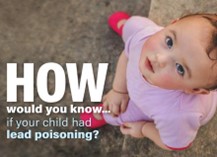Lead Testing
Lead Safe Web Resources Include:
Lead Poisoning Prevention
Childhood Lead Poisoning
Lead Safety at Home
HEPA Vacuum Loaner Program
Financial Incentives and Resources
Lead FAQs
Lead Related Resources
Children become lead poisoned after inhaling lead particles or ingesting lead dust, lead paint chips, or lead-contaminated soil. Children six-years-old and younger are at greatest risk for lead poisoning due to their rapidly growing bodies and the tendency to put their hands or other objects, which may be contaminated with lead dust, into their mouth. Since symptoms rarely show, the only way to confirm if a child has lead poisoning is through a blood test.
lead paint chips, or lead-contaminated soil. Children six-years-old and younger are at greatest risk for lead poisoning due to their rapidly growing bodies and the tendency to put their hands or other objects, which may be contaminated with lead dust, into their mouth. Since symptoms rarely show, the only way to confirm if a child has lead poisoning is through a blood test.
Lead blood testing is mandatory at 12 and 24 months for all Medicaid recipients, children residing in high-risk ZIP code areas, and children with any additional risk factors. All City of Springfield zip codes are classified by the Ohio Department of Health as high-risk zip code areas. Clark County identified high-risk zip codes are 45502, 45503, 45504, 45505, 45506, 45324, 43078, 43140, and 45387.
Parents and/or guardians should talk to their child’s healthcare provider about a lead blood test. During a blood lead test, a small amount of blood is taken from the finger, heel, or arm and tested for lead. There are two types of lead blood tests:
- A finger-prick or heel-prick test — technically known as a capillary test — is usually the first step to determine if a child has lead in their blood and some capillary tests will provide results in as little as 3 minutes. A capillary sample can sometimes yield inaccurate results, and for this reason, a capillary test result that shows a blood lead level at or above the CDC’s blood lead reference value of 3.5 μg/dL (micrograms of lead per deciliter of blood) is followed by a second test, a venous draw, to confirm.
- A venous blood draw takes blood from the child’s vein. This type of test can take a few days to receive results and is often used to confirm blood lead levels seen in the first capillary test.
Initial finger-prick or heel-prick testing is available at the Clark County Combined Health District (CCCHD) for children and adults.
CCCHD testing is quick and reliable, the appointments only take 20 minutes! A parent or guardian must be present for consent for a child’s test which is free for Medicaid recipients. Many private insurance policies also cover the $20 capillary test cost. However, no one will be turned away for an inability to pay.
If the CCCHD capillary test result is 3.5 μg/dL or higher, CCCHD’s lead case manager will provide an order for the child or adult to have their venous draw through Nationwide Children’s ChildLab located at 1644 N Limestone St.
If transportation is an issue, the lead case manager can assist with other arrangements. Insurance is billed by ChildLab for the service. If uninsured or paying cash, a minimal fee is charged at time of service.
CCCHD lead testing is available weekdays by appointment only. To schedule a CCCHD lead test call us 937-390-5600 and ask for Randi at extension 266.
Lead testing is also recommended for pregnant women living in a high-risk zip code area and for pregnant women with a history of lead poisoning as lead can be transferred from mother to unborn baby. For more information about pregnancy and lead safety, click here.
Click here to learn more about the Center for Disease Control and Prevention’s recommendations regarding elevated blood lead levels.
